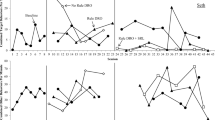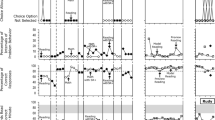Abstract
The present study examines maximization of reinforcement by two autistic individuals under conditions of no instructions, accurate instructions, and inaccurate instructions. Accuracy of instructions and magnitude of reinforcement for differential responding in a choice paradigm were systematically varied across phases. Subject one maximized reinforcement across all three conditions in seven experimental phases. Subject two maximized across these same seven phases, but also experienced three additional phases. In two of the additional phases, subject two maximized reinforcement. In a ninth phase, when reinforcement was intermittent rather than continuous, he failed to maximize reinforcement. Implications of the results for the controversies surrounding the concept of rule-governed behavior are discussed.
Similar content being viewed by others
References
Baron, A., & Galizio, M. (1983). Instructional control of human operant behavior. The Psychological Record, 33, 495–520.
Buskist, W.F., Bennett, R.H., & Miller, H.L. Jr. (1981). Effects of instructional constraints on human fixed-interval performance. Journal of the Experimental Analysis of Behavior, 35, 217–225.
Catania, A.C. (1986). On the differences between verbal and nonverbal behavior. The Analysis of Verbal Behavior, 4, 2–9.
DeGrandpre, R. J., & Buskist, W. F. (1991). Effects of accuracy of instructions on human behavior: Correspondence with reinforcement contingencies matters. The Psychological Record, 41, 371–384.
Galizio, M. (1979). Contingency-shaped and rule-governed behavior: Instructional control of human loss avoidance. Journal of the Experimental Analysis of Behavior, 31, 53–70.
Glenn, S.S. (1987). Rules as environmental events. The Analysis of Verbal Behavior, 5, 29–32.
Hayes, S.C., Brownstein, A.J., Haas, J.R., & Greenway, D.E. (1986). Instructions, multiple schedules, and extinction: Distinguishing rule-governed from schedule-controlled behavior. Journal of the Experimental Analysis of Behavior, 46, 137–147.
Hayes, S.C., & Hayes, L.J. (1989). The verbal action of the listener as a basis for rule-governance. In S.C. Hayes (ed.) Rule-governed behavior: Cognition, contingencies, and instructional control (pp. 153–190). New York: Plenum Press.
Hayes, S.C., Zettle, R.D., & Rosenfarb, I. (1989). Rule-following. In S.C. Hayes (ed.) Rule-governed behavior: Cognition, contingencies, and instructional control (pp. 191–220). New York: Plenum Press.
Higgins, ST., & Morris, E.K. (1984). Generality of free-operant avoidance conditioning to human behavior. Psychological Bulletin, 96, 247–272.
Inesta, E.R., & Sanchez, H. M. (1990). Interaction of contingencies and rule instructions in the performance of human subjects in conditional discrimination. The Psychological Record, 40, 565–586.
Kaufman, A., Baron, A., & Kopp, R.E. (1966). Some effects of instructions on human operant behavior. Psychonomic Monograph Supplements, 1, 243–250.
Lippman, L.G. & Meyer, M.E. (1967). Fixed-interval performance as related to instructions and subjects’ verbalizations of the contingency. Psychonomic Science, 8, 135–136.
Lowe, C.F. (1979). Determinants of human operant behavior. In M.D. Zeiler and P. Harzem (Eds.), Advances in analysis of behaviour: Vol. 1: Reinforcement and the organization of behaviour (pp. 159–192). New York: John Wiley and Sons.
Matthews, B.A., Shimoff, E., Catania, A.C., & Sagvolden, T. (1977). Uninstructed human responding: Sensitivity to ratio and interval schedules. Journal of the Experimental Analysis of Behavior, 27, 453–467.
Mullins, M., & Rincover, A. (1985). Comparing autistic and normal children along the dimensions of reinforcement maximization, stimulus sampling, and responsiveness to extinction. Journal of Experimental Child Psychology, 40, 350–374.
Perone, M., Galizio, M., & Baron, A. (1988). The relevance of animal-based principles in the laboratory study of human operant conditioning. In G. Davey and C Cullen (Eds.) Human operant conditioning and behavior modification (pp. 59–86). New York: John Wiley and Sons.
Reese, H.W. (1989). Rules and rule-governance: Cognitive and behavioristic views. In S. C. Hayes (ed.) Rule-governed behavior: Cognition, contingencies, and instructional control (pp. 3–84). New York: Plenum Press.
Shimoff, E., Catania, A.C., & Matthews, B.A. (1981). Uninstructed human responding: Responsivity of low-rate performance to schedule contingencies. Journal of the Experimental Analysis of Behavior, 36, 207–220.
Skinner, B.F. (1963). Operant behavior. American Psychologist, 18, 503–515.
Skinner, B.F. (1989). Recent issues in the analysis of behavior. Toronto: Merrill Publishing Company.
Vargas, E.A. (1988). Event-governed and verbally-governed behavior. The Analysis of Verbal Behavior, 6, 11–22.
Vaughan, M. (1989). Rule-governed behavior in behavior analysis. In S.C. Hayes (ed.) Rule-governed behavior: Cognition, contingencies, and instructional control (pp. 97–118). New York: Plenum Press.
Weiner, H. (1970). Instructional control of human operant responding during extinction following fixed-ratio conditioning. Journal of the Experimental Analysis of Behavior, 13, 391–394.
Author information
Authors and Affiliations
Additional information
We would like to acknowledge the contribution of Stanley Sham of Queens College, CUNY for the design and construction of the apparatus used in the current experiment.
Rights and permissions
About this article
Cite this article
Newman, B., Buffington, D.M. & Hemmes, N.S. Maximization of reinforcement by two autistic students with accurate and inaccurate instructions. Analysis Verbal Behav 9, 41–48 (1991). https://doi.org/10.1007/BF03392859
Published:
Issue Date:
DOI: https://doi.org/10.1007/BF03392859




